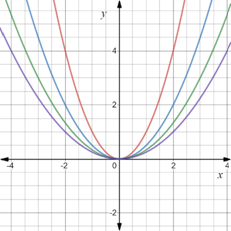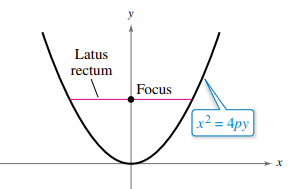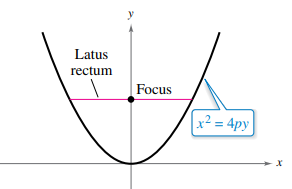
Concept explainers
To graph: The equation of parabola
Explanation of Solution
Given information:
The standard form of equation of parabola
Graph:
Consider the standard form of equation of parabola
For
For
For
For
On the Cartesian plane plot the parabolas.
The result obtained on screen is provided below,

The red curve represents
Interpretation:
As the value of p increase from 1 to 4 the graph becomes wider than the previous one.
To calculate: The focus of the parabola
Answer to Problem 84E
The focus of the parabola
Explanation of Solution
Given information:
The standard form of equation of parabola
Formula used:
The focus of the parabola of the form
Calculation:
Consider the standard form of equation of parabola
For
For
For
For
Recall thatfocus of the parabola of the form
For
For
For
For
Thus, the focus of the parabola
To calculate: The length of latus rectum of the parabola
Answer to Problem 84E
The length of latus rectum of the parabola
Explanation of Solution
Given information:
The standard form of equation of parabola

Formula used:
The focus of the parabola of the form
Calculation:
Consider the standard form of equation of parabola

Recall thatfocus of the parabola of the form
For
Therefore, there are two points
For
Therefore, there are two points
For
Therefore, there are two points
For
Therefore, there are two points
The length of latus rectum of parabola of the form
Thus, the length of latus rectum of the parabola
To describe: The use of latus rectum to sketch the parabola.
Answer to Problem 84E
The length of latus rectum is used to identity that how narrow or shallow the parabola is.
Explanation of Solution
Given information:
The standard form of equation of parabola
Consider the standard form of equation of parabola
Recall thatfocus of the parabola of the form
Recall that the length of latus rectum is
The length of latus rectum is used to identity that how narrow or shallow the parabola is.
When a parabola is to be sketched, first plot the vertex and focus of the parabola. Then plot the two points on the parabola that connects the line segment of latus rectum.
At the end join the two points with the vertex to construct the parabola.
Chapter 10 Solutions
EBK PRECALCULUS W/LIMITS
- 4. Consider the initial value problem y' = 3x(y-1) 1/3, y(xo) = yo. (a) For what points (co, yo) does the IVP have a solution? (b) For what points (xo, yo) does the IVP have a unique solution on some open interval that contains 20? (c) Solve the IVP y' = 3x(y-1) 1/3, y(0) = 9 and determine the largest open interval on which this solution is unique.arrow_forwardFind the limit. (If the limit is infinite, enter 'oo' or '-o', as appropriate. If the limit does not otherwise exist, enter DNE.) lim X→ ∞ (✓ 81x2 - 81x + x 9x)arrow_forward2) Compute the following anti-derivative. √1x4 dxarrow_forward
- Question 3 (5pt): A chemical reaction. In an elementary chemical reaction, single molecules of two reactants A and B form a molecule of the product C : ABC. The law of mass action states that the rate of reaction is proportional to the product of the concentrations of A and B: d[C] dt = k[A][B] (where k is a constant positive number). Thus, if the initial concentrations are [A] = = a moles/L and [B] = b moles/L we write x = [C], then we have (E): dx dt = k(ax)(b-x) 1 (a) Write the differential equation (E) with separate variables, i.e. of the form f(x)dx = g(t)dt. (b) Assume first that a b. Show that 1 1 1 1 = (a - x) (b - x) - a) a - x b - x b) (c) Find an antiderivative for the function f(x) = (a-x) (b-x) using the previous question. (d) Solve the differentiel equation (E), i.e. find x as a function of t. Use the fact that the initial concentration of C is 0. (e) Now assume that a = b. Find x(t) assuming that a = b. How does this expression for x(t) simplify if it is known that [C] =…arrow_forward3) Find the volume of the solid that lies inside both the sphere x² + y² + z² cylinder x²+y² = 1. = 4 and thearrow_forward1) Compute the following limit. lim x-0 2 cos(x) 2x² - x4arrow_forward
- y = f(x) b C The graph of y = f(x) is shown in the figure above. On which of the following intervals are dy > 0 and dx d²y dx2 <0? I. aarrow_forward3 2 1 y O a The graph of the function f is shown in the figure above. Which of the following statements about f is true? о limb f(x) = 2 Olima f(x) = 2 о lima f (x) = lim x →b f(x) → f (x) = 1 limb. lima f(x) does not existarrow_forwardQuestion 1 (1pt). The graph below shows the velocity (in m/s) of an electric autonomous vehicle moving along a straight track. At t = 0 the vehicle is at the charging station. 1 8 10 12 0 2 4 6 (a) How far is the vehicle from the charging station when t = 2, 4, 6, 8, 10, 12? (b) At what times is the vehicle farthest from the charging station? (c) What is the total distance traveled by the vehicle?arrow_forwardQuestion 2 (1pt). Evaluate the following (definite and indefinite) integrals (a) / (e² + ½) dx (b) S (3u 2)(u+1)du (c) [ cos³ (9) sin(9)do .3 (d) L³ (₂ + 1 dzarrow_forward= Question 4 (5pt): The Orchard Problem. Below is the graph y f(t) of the annual harvest (assumed continuous) in kg/year from my cranapple orchard t years after planting. The trees take about 25 years to get established, and from that point on, for the next 25 years, they give a fairly good yield. But after 50 years, age and disease are taking their toll, and the annual yield is falling off. 40 35 30 。 ៣៩ ថា8 8 8 8 6 25 20 15 10 y 5 0 0 5 10 15 20 25 30 35 40 45 50 55 60 The orchard problem is this: when should the orchard be cut down and re- planted, thus starting the cycle again? What you want to do is to maximize your average harvest per year over a full cycle. Of course there are costs to cutting the orchard down and replanting, but it turns out that we can ignore these. The first cost is the time it takes to cut the trees down and replant but we assume that this can effectively be done in a week, and the loss of time is negligible. Secondly there is the cost of the labour to cut…arrow_forwardnd ave a ction and ave an 48. The domain of f y=f'(x) x 1 2 (= x<0 x<0 = f(x) possible. Group Activity In Exercises 49 and 50, do the following. (a) Find the absolute extrema of f and where they occur. (b) Find any points of inflection. (c) Sketch a possible graph of f. 49. f is continuous on [0,3] and satisfies the following. X 0 1 2 3 f 0 2 0 -2 f' 3 0 does not exist -3 f" 0 -1 does not exist 0 ve tes where X 0 < x <1 1< x <2 2arrow_forwardarrow_back_iosSEE MORE QUESTIONSarrow_forward_iosRecommended textbooks for you
 Calculus: Early TranscendentalsCalculusISBN:9781285741550Author:James StewartPublisher:Cengage Learning
Calculus: Early TranscendentalsCalculusISBN:9781285741550Author:James StewartPublisher:Cengage Learning Thomas' Calculus (14th Edition)CalculusISBN:9780134438986Author:Joel R. Hass, Christopher E. Heil, Maurice D. WeirPublisher:PEARSON
Thomas' Calculus (14th Edition)CalculusISBN:9780134438986Author:Joel R. Hass, Christopher E. Heil, Maurice D. WeirPublisher:PEARSON Calculus: Early Transcendentals (3rd Edition)CalculusISBN:9780134763644Author:William L. Briggs, Lyle Cochran, Bernard Gillett, Eric SchulzPublisher:PEARSON
Calculus: Early Transcendentals (3rd Edition)CalculusISBN:9780134763644Author:William L. Briggs, Lyle Cochran, Bernard Gillett, Eric SchulzPublisher:PEARSON Calculus: Early TranscendentalsCalculusISBN:9781319050740Author:Jon Rogawski, Colin Adams, Robert FranzosaPublisher:W. H. Freeman
Calculus: Early TranscendentalsCalculusISBN:9781319050740Author:Jon Rogawski, Colin Adams, Robert FranzosaPublisher:W. H. Freeman
 Calculus: Early Transcendental FunctionsCalculusISBN:9781337552516Author:Ron Larson, Bruce H. EdwardsPublisher:Cengage Learning
Calculus: Early Transcendental FunctionsCalculusISBN:9781337552516Author:Ron Larson, Bruce H. EdwardsPublisher:Cengage Learning
 Calculus: Early TranscendentalsCalculusISBN:9781285741550Author:James StewartPublisher:Cengage Learning
Calculus: Early TranscendentalsCalculusISBN:9781285741550Author:James StewartPublisher:Cengage Learning Thomas' Calculus (14th Edition)CalculusISBN:9780134438986Author:Joel R. Hass, Christopher E. Heil, Maurice D. WeirPublisher:PEARSON
Thomas' Calculus (14th Edition)CalculusISBN:9780134438986Author:Joel R. Hass, Christopher E. Heil, Maurice D. WeirPublisher:PEARSON Calculus: Early Transcendentals (3rd Edition)CalculusISBN:9780134763644Author:William L. Briggs, Lyle Cochran, Bernard Gillett, Eric SchulzPublisher:PEARSON
Calculus: Early Transcendentals (3rd Edition)CalculusISBN:9780134763644Author:William L. Briggs, Lyle Cochran, Bernard Gillett, Eric SchulzPublisher:PEARSON Calculus: Early TranscendentalsCalculusISBN:9781319050740Author:Jon Rogawski, Colin Adams, Robert FranzosaPublisher:W. H. Freeman
Calculus: Early TranscendentalsCalculusISBN:9781319050740Author:Jon Rogawski, Colin Adams, Robert FranzosaPublisher:W. H. Freeman
 Calculus: Early Transcendental FunctionsCalculusISBN:9781337552516Author:Ron Larson, Bruce H. EdwardsPublisher:Cengage Learning
Calculus: Early Transcendental FunctionsCalculusISBN:9781337552516Author:Ron Larson, Bruce H. EdwardsPublisher:Cengage Learning